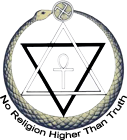The Days and Nights of Brahma
Secret Doctrine (1888 Edition)
Book 1, Part II, page 368
VII.
THE DAYS AND NIGHTS OF BRAHMA.
This is the name given to the Periods called Manvantara (Manu-antara, or between the Manus) and Pralaya (Dissolution); one referring to the active periods of the Universe, the other to its times of relative and complete rest — according to whether they occur at the end of a “Day,” or an “Age” (a life) of Brahma. These periods, which follow each other in regular succession, are also called Kalpas, small and great, the minor and the Maha Kalpa; though, properly speaking, the Maha Kalpa is never a “day,” but a whole life or age of Brahma, for it is said in the Brahma Vaivarta: “Chronologers compute a Kalpa by the Life of Brahma; minor Kalpas, as Samvarta and the rest, are numerous.” In sober truth they are infinite; as they have never had a commencement, i.e., there never was a first Kalpa, nor will there ever be a last one, in Eternity.
One Parardha — in the ordinary acceptation of this measure of time — or half of the existence of Brahma (in the present Maha Kalpa) has already expired; the last Kalpa was the Padma, or that of the Golden Lotos; the present one being Varaha* (the “boar” incarnation, or Avatar).
Footnote:
* There is a curious piece of information in the Buddhist esoteric traditions. The exoteric or allegorical biography of Gautama Buddha shows this great Sage dying of an indigestion of pork and rice, a very prosaic end, indeed, having little of the solemn element in it. This is explained as an allegorical reference to his having been born in the “Boar,” or Varaha-Kalpa when Brahma assumed the form of that animal to raise the Earth out of the “Waters of Space.” And as the Brahmins descend direct from Brahma and are, so to speak, identified with him; and as they are at the same time the mortal enemies of Buddha and Buddhism, we have the curious allegorical hint and combination. Brahminism (of the Boar, or Varaha Kalpa) has slaughtered the religion of Buddha in India, swept it away from its face; therefore Buddha, identified with his philosophy, is said to have died from the effects of eating of the flesh of a wild hog.
The idea alone of one who established the most rigorous vegetarianism and respect for animal life — even to refusing to eat eggs as vehicles of a latent future life — dying of a meat indigestion, is absurdly contradictory and has puzzled more than one Orientalist. But this explanation, unveiling the allegory, explains all the rest. The Varaha, however, is no simple boar, and seems to have meant at first some antediluvian lacustrine animal “delighting to sport in water.” (Vayu Purana.)
Back to Multiverse or Parabrahm

